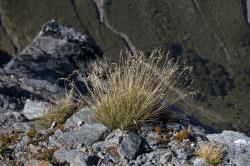- Taxon
- Gallery
- = Poa intermedia Buchanan, Indig. Grasses of N. Z. t. 48a (1880) nom. illeg., non Poa intermedia Koeler 1802
- ≡ Poa colensoi var. intermedia (Buchanan) Cheeseman, Man. New Zealand Fl. 908 (1906)
- = Poa colensoi var. breviligulata Petrie, Trans. & Proc. New Zealand Inst. 47: 57 (1915)
- = Poa colensoi var. guthrie-smithiana (Petrie) Zotov, Trans. Roy. Soc. New Zealand 73: 236 (1943)
Small, blue-green or light green, narrow-leaved, stiff tussocks, 5–30–(70) cm, with tightly-packed shoots; branching intravaginal; leaf-blades disarticulating at ligule. Leaf-sheath light straw-coloured, later greyish brown, somewhat coriaceous, glabrous, indistinctly ribbed, tightly inrolled with narrow hyaline margins; upper sheaths sometimes purplish. Ligule 0.5–5.5 mm, entire, apically glabrous, rounded to tapered, abaxially minutely scabrid or smooth. Leaf-blade 5–15–(30) cm, usually tightly inrolled and c. 0.5 mm diam., abaxially glabrous, adaxially slightly to densely short pubescent-scabrid; margins finely scabrid, tip truncate, almost smooth with a few minute prickle-teeth, or fine-acicular and finely scabrid. Culm 5–20–(40) cm, erect, usually overtopping but often = leaves, internodes glabrous. Panicle 1–10–(15) cm; branches ± spreading, few to many, often short, almost filiform, smooth to ± finely scabrid, tipped by 1–3 rather large spikelets. Spikelets (3.5)–5–7–(10.5) mm, 2–5–(7)-flowered, light green to brownish. Glumes subequal, subacute to acute, glabrous, midnerve with a few minute prickle-teeth near tip; lower 2–3–(4) mm, 1–3-nerved, narrow elliptic-lanceolate, upper (2)–2.5–3.5–(4) mm, 3-nerved, ovate- to elliptic-lanceolate; margins minutely fimbriate. Lemma (2.5)–3–4–(5) mm, 5-nerved, ovate- to elliptic-lanceolate, subobtuse, in some long-liguled plants with fine hairs on lower ½-⅓ of midnerve and short hairs near base of lateral nerves, otherwise nerves scabrid or smooth, internerves densely scabrid to smooth, rarely with a few scattered hairs near base; margins glabrous to finely ciliate-scabrid. Palea 2–4–(5) mm, keels finely ciliate-scabrid, interkeel minutely pubescent-scabrid. Callus in long-liguled forms sometimes with a tuft of tangled hairs, otherwise glabrous or very rarely with a few short wispy hairs. Rachilla 0.5–1 mm, smooth to strongly densely scabrid. Lodicules c. 0.5 mm. Anthers 1–2 mm. Caryopsis c. 1–2 × 0.5 mm. 2n= 28. Plate 7E.
[From: Edgar and Connor (2000) Flora of New Zealand. Volume 5 (second printing).]




